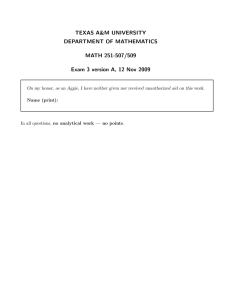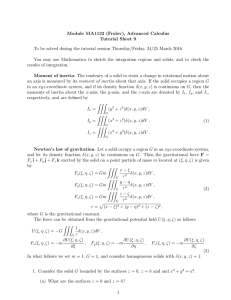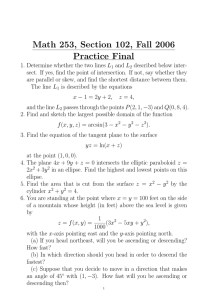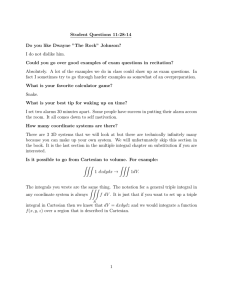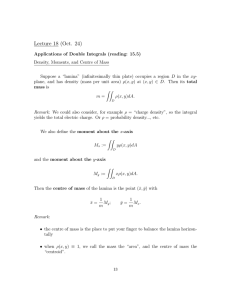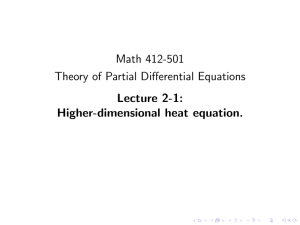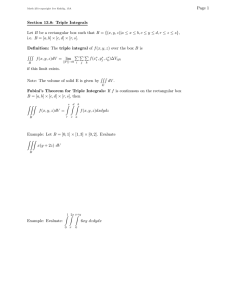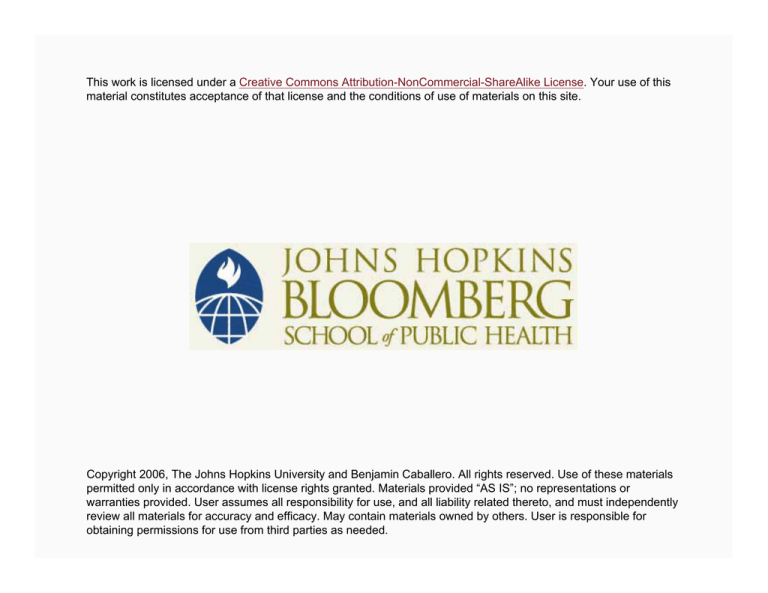
This work is licensed under a Creative Commons Attribution-NonCommercial-ShareAlike License. Your use of this
material constitutes acceptance of that license and the conditions of use of materials on this site.
Copyright 2006, The Johns Hopkins University and Benjamin Caballero. All rights reserved. Use of these materials
permitted only in accordance with license rights granted. Materials provided “AS IS”; no representations or
warranties provided. User assumes all responsibility for use, and all liability related thereto, and must independently
review all materials for accuracy and efficacy. May contain materials owned by others. User is responsible for
obtaining permissions for use from third parties as needed.
Energy Homeostasis in Humans
Benjamin Caballero, MD, PhD
Johns Hopkins University
Section A
General Concepts of Energy Metabolism
Types of Energy
Solar
Chemical
Mechanical
Thermal
Electrical
4
Units of Energy
Calorie
− Defined as the amount of heat required to rise the
temperature of
one kg of water from 14.5 to 15.5° C
− Also defined based on the heat of combustion of benzoic
acid (thermochemical calorie)
− Standardized in 1956—one cal = 4.1868 Joules
5
Units of Energy
Joule
− Defined as the energy expended when one kg is moved
one meter by a force of one Newton
Watt
− Expresses rate of energy expenditure per unit time, i.e.,
work (J/sec)
6
1 L of O2 of
= 4.825
kcal
Bioenergetics
Gas Exchange
1 g/atom of O2 = 3 mol of ATP
7
Bomb Calorimeter
Diagram created by JHSPH CTLT
8
Energy Combustion
Starch
Fat
Protein
O2
(ml)
828
2019
966
CO2
(ml)
828
1427
781
RQ
1.00
0.70
0.81
Energy
(kcal)
4.183
9.461
4.442
9
Energy in Foods
Kcal/g
Heat of
Comb ustion
Availabilit y
Loss
Net
Meat
Butter
Starch
Ethanol
5.35
9.12
4.12
7.1
92%
95%
99%
100%
1.25
—
—
tr.
4.0
9.0
4.0
7.0
10
Section B
Energy Balance and Measurement of Energy Expenditure
Energy Balance
Energy IN = Energy OUT
12
Measurement of Energy Balance
24 hrs
Energy Intake
Energy Expenditure
13
Measurement of Energy Balance
24 hrs
Energy Intake
Energy Expenditure
Food freq. quest.
24-hr recall
Food records
Food weighing
Direct observation
14
Measurement of Energy Balance
24 hrs
Energy Expenditure
Energy Intake
Food freq. quest.
24-hr recall
Food records
Food weighing
Direct observation
Gas exchange calorimetry
Heart rate monitoring
Estimated from activity
− Motion sensors
− Activity diary
− Direct observation
Doubly labeled water (D218O)
15
Components of EE
Basal Metabolic Rate
(BMR, REE)
16
Components of EE
Thermic Effects of Food
(TEF, FIT)
Basal Metabolic Rate
(BMR, REE)
17
Components of EE
Physical Activity (PA)
Thermic Effects of Food
(TEF, FIT)
Basal Metabolic Rate
(BMR, REE)
18
Daily Energy Balance
(>650,000 kcal)
Stores
Intake
As total kcal
Range
Fat 125,000 kcal
1000 kcal
As % stores
0.8%
1000 kcal
500 kcal
Oxidation
Protein 40,000 kcal
Carbohydrate 2000 kcal
1.3%
50%
19
The Doubly-Labeled Water Method
H loss:
H2 O
Water
2
H2 18O
Body Water
O loss:
H218O
Water
“Normal” water:1H2
16O
C18 O2
Carbon Dioxide
20
Disappearance Rates of DLW Tracers
21
Section C
Energy Requirements
Dietary Reference Intakes
Frequency Distribution
of Individual Requirements
EAR
2 s.d.
Increasing Intake
RDA
193-01
23
Determination of Dietary Energy Requirements: Factorial Method
TEE
Physical Activity Allowance
Food-Induced Thermogenesis (ignored)
BMR (measured/predicted)
24
Limitations of Previous Approach
BMR not constant throughout the day
Unreliable data on energy cost of physical activities, and only
estimated for selected activities
EPOC, fidgeting, other involuntary activities not accounted for
25
Selection of Approach for Current Revision
Use energy expenditure to estimate dietary energy
requirements
Use total daily energy expenditure (TEE) measured by the
doubly-labeled water technique
26
Adequacy Indicator
BMI
Strengths
− Recognized link to health outcomes
− Reflects relationship of weight and height
− Good population data in U.S. and other countries
27
Adequacy Indicator
BMI
Limitations
− Not best indicator of body adiposity
− Cutoffs may not be valid across populations
− Some difficulty in defining cutoff points in children and
across populations/countries
28
Estimated Energy Requirement (EER)
A level of dietary energy intake sufficient to maintain a stable
healthy body weight and an adequate level of physical
activity
Differs from EAR in that it is not a distribution of intakes
reflecting physiological variability
29
Normative DLW Database TEE by Age
TEE (kcal/d)
4000
z
z
z z
zz
z
zz
zz
z zzz
zz
z
zzz
zz
z
zz
zz
zz
z
zz
zzz
zz
z z
z
zz
z
zz
zz z
z
z
z
z
zzz
z
z z
z
zz z
z
zz
zz
zz
zz
zz
zz
z
z
z
z
z
z
z
z
z
z
z
z
z
z
z zz
z
z
z z
z
z
z
z
z
zzzzz
zz
zz
z
z
zz
z
z
z
z
zz
zz
z
zzzz zz
z
z
z
z
z
z
z
z
z
zz
zz
zz
z
z
z
z
z
3000
2000
1000
z
z
z
Female
z Male
zz
zz
z
z zz z z
z
z
z
zz zz
zzzzz z
zzz z zz zz
zz
z
z z z z zz z z
z
z
zz
z
z
z
z
z
zzz
zz z z
zz
z
z
z
z z z z zz zzzz
z
z
zz
z
z
z
z
z
zz zzz
z
z
z z
z
zzz z
zzz
z
zzz z
z
z
z
z
z
z
z
z
z
z
z
z
z
z
z
zz
zz
z
z
z
zz
z
z zzz
z zz zzz z zz
z
z z
zz
z z
zz z z z
z zz z
zzz z z
zz zz z
zzz
z
z
z
z
z
z zz z z
zz
zz
zz zz z
z z
z
zz
z
z
zzz
z
z
z
z
zzzz
zzz z
z
z
z
z
z
z
z
z
z
z
z zz z z
zz
zz z
z
z zz
z
z
z
z
z
z
z
z
z
z
z
z
z
z
z
z
z zz z
z zz zz
z z
z zz z
z
zzz zzz z
z
z
zz
zzz z z
z z zzz z z
z
z
z
zz
zz z
z
zz z
z zzzzzz z
z zzzz z z z
zzz
z
z
zz
z
z
z
z
z
z zzzzzz
z
z
z z
z
zz zz
z
zz
zz
z z zz
z
zz z
z
z z
0
0
20
40
60
80
100
Age (y)
30
Measures of Physical Activity
PAL—TEE / BEE
MET— O2 consumption of 3.5 mL/kg/min
(= 0.0175 kcal/kg/min)
PAL equivalents of METs
− 0.0175 x 1.15 / 0.9
31
PAL Levels
Mean
PA Category
Range
F
M
Sedentary
1.0–1.39
1.23
1.29
Low Active
Active
Very Active
1.4–1.59
1.6–1.89
1.9–2.5
1.52
1.74
2.09
1.51
1.74
2.06
Data from Institute of Medicine/National Academy of Sciences
32
DLW Database: Distribution of PAL Levels
100
90
80
70
60
n 50
40
30
20
10
0
Females
Males
Sedentary
Low Active
Active
Very Active
PAL Level
33
Equation for Prediction of TEE: General Models
0–2 Years of Age
TEE = 89 x Weight – 100
Ages 3 Years and Over
TEE = A + B x Age + PA x (D x Weight + E x Height)
− A—Constant term
− B—Age coefficient
− PA—Physical activity coefficient
− D—Weight coefficient
− E—Height coefficient
34
Energy Allowances +
PA
Desirable activity
Catch-up growth
Infection
TEF
BMR
Adapted by CTLT from Institute of Medicine/National Academy of Sciences
35
Factors Affecting Energy Requirements
Food
Security
Impact of
Structural
Adjustments
Food Aid
Energy
Requirements
Agricultural
Development
Impact of
Urbanization
Land Use
Analysis
Farming
Systems
Commodity
Projections
Household
Economy
Food Demand
Analysis
Copyright 2005, Benjamin Caballero and The Johns Hopkins University. All rights reserved. Use of these materials permitted
only in accordance with license rights granted. Materials provided “AS IS”; no representations or warranties provided. User
assumes all responsibility for use, and all liability related thereto, and must independently review all materials for accuracy
and efficacy. May contain materials owned by others. User is responsible for obtaining permissions for use from third parties
36
as needed.

